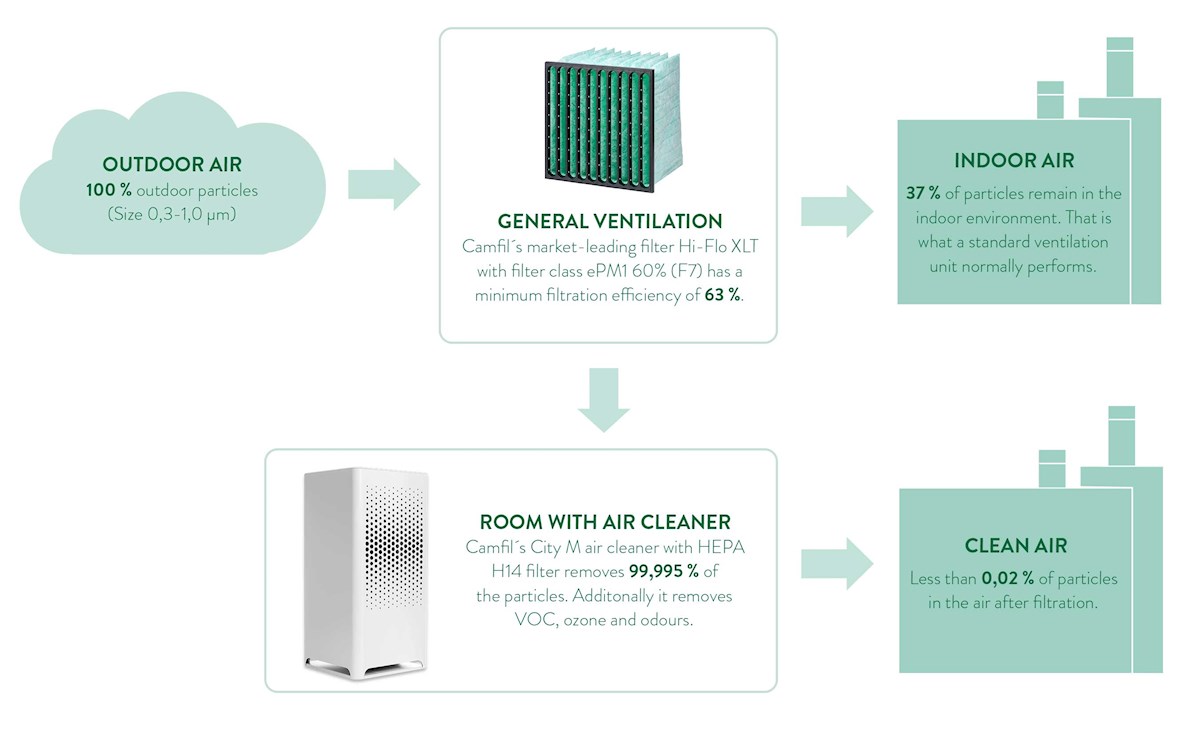Autumn and winter months often bring colds, flu, and other illnesses. We spend up to 90% of our time indoors which can easily lead to infecting our surroundings. When we cough and sneeze, we secrete small drops that can spread several meters and stay suspended in the air for a long time. Once the droplets have fallen on surfaces, viruses and bacteria can survive for several days depending on the environment and conditions. Therefore, it is important that we cover coughs and sneezes, and keep the hands clean to help prevent the spread of serious respiratory illnesses.

The harmful effects of 'air pollution' is not a close secret. There is a lot of confirming the new health risks associated with air pollution. In a study published by the European Public Health Alliance (EPHA) on the SARS virus from 2003, researchers were able to see a connection between poor air quality and the high number of infected people, which has now been linked to the Coronavirus (COVID-19). According to EPHA, COVID-19 patients in polluted cities are 84% more likely to die from the infection than patients in moderately polluted cities.
”The quality of indoor air inside offices, and other workplaces is important not only for workers' comfort but also for their health. Poor indoor air quality (IAQ) has been tied to symptoms like headaches, fatigue, trouble concentrating, and irritation of the eyes, nose, throat, and lungs. Also, some specific diseases have been linked to specific air contaminants or indoor environments, like asthma with damp indoor environments. In addition, some exposures, such as asbestos and radon, do not cause immediate symptoms but can lead to cancer after many years.”– United States Department of Labor (Occupational Safety and Health Administration)
How much and what we emit for pollutants has changed over time, but above all reasoning, the biggest challenge today is that we emit larger amounts of smaller particles in the air, called PM1 particles. PM1 particles are very small particles, size one micrometer and smaller, that is less than one-thousandth of a millimeter. With the advancement in air filtration technology, it is possible to filter these harmful PM1 particles, but it still entails challenges. For example, the most commonly installed air filtration solution, class ePM1 60% (F7), removes about 60% of these particles, and the rest passes into the area with the ventilation. It is difficult for the human body’s natural filter to resist these left-over particles in the indoor environment, hence these pollutants penetrate the body more easily.
The outdoor air is difficult for us to influence, but employers and facility owners have a responsibility to improve the indoor air and thus contribute to healthier working conditions.
We spend up to 90% of our time indoors, which makes clean air one of the most important priorities in our workplace. It is not only the outdoor air that affects the indoor environment. We greatly influence it ourselves by using chemicals, chemical-based cleaning agents, candles, how often we clean, but also things like plants and textiles have an impact on the air quality. The droplets secreted when we sneeze, and cough is not something that the filters in the ventilation can prevent and filtration depends on many other factors. To avoid the spread of bacteria and viruses in the area, Camfil recommends installing air purifiers.
Air purifiers are available in all possible designs and adapted to different environments. Camfil's City-Series air purifier cleans 99.95% of the air while keeping cleaning costs down. Viruses caught in the filter stick to the media and eventually becomes inactive (dries out and die). The City M mobile air purifier is equipped with particulate and molecular filters to improve IAQ significantly. It is typically installed in rooms up to 75 square metres in area to deliver a healthier indoor environment by removing dust, contaminants, and harmful particles in department stores, offices, schools, hospitals, and homes.

See examples for different environments and filter classes here (link to full pdf with table)
Also, to influence the air that comes from outside and enters through the ventilation system, you must review which filters are installed in the property. Upgrading the filter class on the supply air filter in the property's HVAC-system makes a big difference to the air that is suspended in the room. Many factors affect the indoor environment, e.g. what filters are used in the ventilation system if we use air purifiers, and how the humidity is controlled. The easiest and fastest way to improve air quality (IAQ) is to install high-efficiency air purifiers or air cleaner. There are also testing tools for measuring air quality to make sure you have a good indoor environment - measuring is knowing.

Camfil works actively with the UN's sustainability goals Good Health & Well-being and Sustainable Cities and Communities. Reviewing the air quality in your workplace can make a big difference to employees health and increase productivity. Read more about how we work with sustainability here.
Do you want to get a consultation about which filter solution is best for you and your workplace?